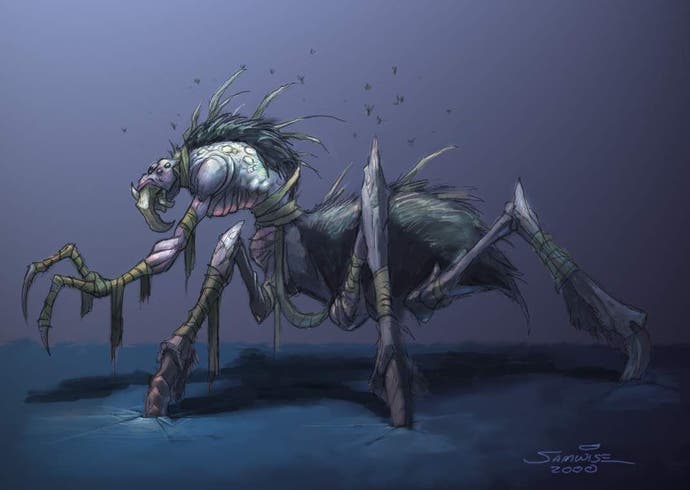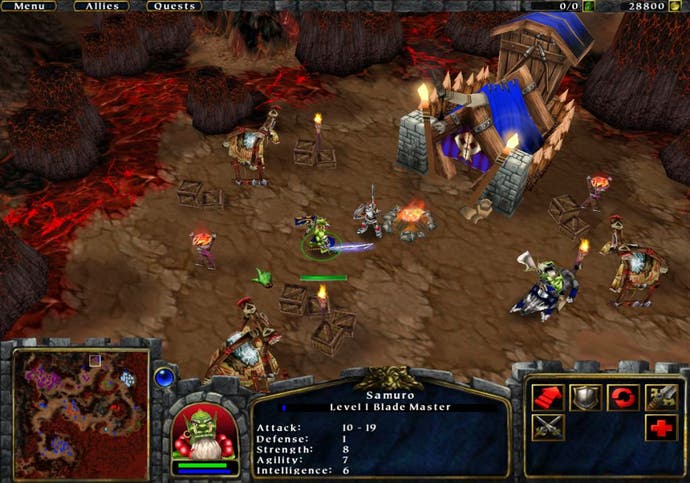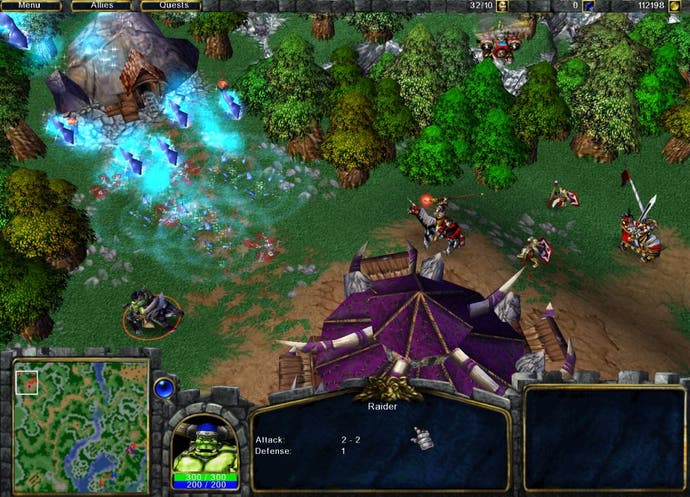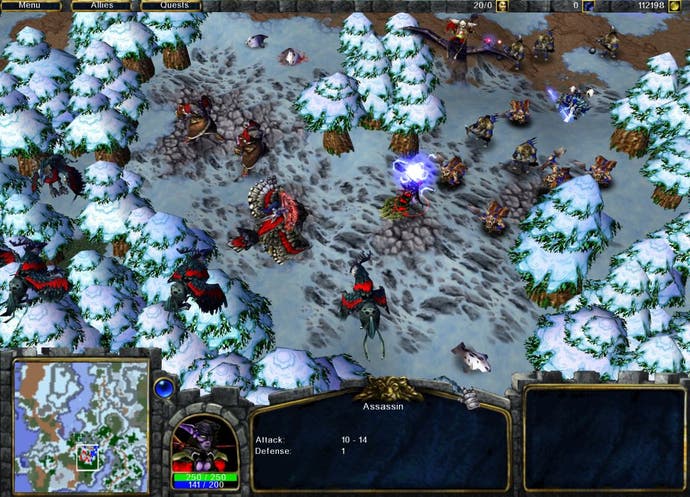Warcraft III
Preview - a first-hand look at Blizzard's latest real-time strategy game
Eighteen months ago EuroGamer was at the official announcement of Warcraft III at ECTS 1999. Developers Blizzard were saying their latest game would be a revolutionary new blend of role-playing and strategy elements, with their first real-time 3D graphics engine powering the whole thing. And mighty impressive it was looking too.
Since then the scope of the game has been cut back somewhat though, with the number of playable races reduced from six to four and those role-playing elements attracting less and less attention. So what's the story? We dropped by the Covent Garden Hotel in central London to find out as Blizzard's Bill Roper demonstrated the latest build of the game...

Something Old, Something New...
Warcraft III is shaping up to be a blend of old familiar faces from the first two games in the series and a selection of new ideas and characters. In fact, much of the game does look eerily familiar, although that's not to say that it is turning into "just another sequel".
The two main races from the previous games (humans and orcs) are now joined by the night elves, undead and demons. The night elves are an ancient race who have been in Azeroth for longer than any of the other civilizations, and their long history will become apparent through their campaign's storyline. Meanwhile the undead look set to put a whole new spin on gameplay, with a different resource system to the other races. They will have to gather dead bodies to regenerate or construct new units, and so when you are playing as the undead (or playing against them for that matter) you will have to stick around on the battlefield once a fight is over to gather or protect corpses.
Originally the demonic Burning Legion (which forms the centerpiece of the game's storyline) was going to be fully playable, but this just didn't work out as trying to fit them into the game detracted from their individuality. Somehow having little demons that ran around digging gold and building huts didn't quite fit with the whole all-powerful evil from beyond the stars feel Blizzard seem to have been aiming at. Instead they will pop up throughout the single player campaigns of the other races to raise mayhem and generally look threatening.
Although these are the main playable races, there are other people in the world. As well as the minor players that other races can recruit (such as dwarven troops for the human armies), there are also now non-player units in many of the maps, including everything from trolls to centaurs. These will attack anybody that strays near them, and as well as adding some colour to the game they should also act as a deterrent to base rushing in multiplayer games, forcing you to advance further before you can break out of your base and start searching for your opponents. They will also encourage the player to explore the map, as killing these neutral monsters will give your heroes experience and are also the only source of mana stones, one of the two resources in the game.

Hero
Probably the biggest change from the Warcraft formula is the increased focus on individual heroes rather than overwhelming forces - the game is supposed to reward small armies with good tactics rather than simply giving victory to whoever can mine resources the fastest and dump a huge number of grunts into their enemy's base.
Various classes of hero are available to buy, each with their own statistics and special abilities. Strength effects the amount of damage your hero causes, agility will alter their movement rate, while a higher intelligence score gives more spell points and allows you to recharge them more rapidly. And as your heroes gain experience throughout a campaign their stats will rise, with each class producing different results. For example, a paladin is a fairly balanced character, while rangers concentrate on increasing their agility.
Each class also has a range of unique skills, which can become ridiculously powerful in later levels - dwarven mountain kings can summon an entire gold mine out of thin air at high levels, while rangers gain a lethal poison arrow attack which slowly drains the victim's health until they are dead. Add to this the ability to use a variety of magical items and potions, and heroes should become a vital part of any army.
Thus far nobody has quite managed to pull off this mixture of role-playing style heroes and real-time strategy though. The biggest problem is that losing a high level hero is a pretty traumatic experience, and often leads to an instant "game over" screen. This tends to discourage people from actually using their heroes in the later stages of a game, for fear of losing them. Warcraft III should get around this with the Altar of Kings, a handy building which allows you to resurrect fallen heroes. This means that, although you will have to pay a high price to recover a powerful hero, at least you can continue the game and won't have to start training a new hero from scratch.

All Your Base
Although Blizzard have added some new role-playing elements to the Warcraft formula, at its heart it is still very much a real-time strategy game. The resource system has been simplified somewhat, but you will still have to build mines and dig for gold. Mana stones have also been added to the game, and are used to research some technologies, to purchase new heroes, and to buy some types of item.
Base building was played down in the original Warcraft III presentation, but it is still an important part of the game, with different buildings allowing different troop types to be bought and providing other benefits. There are also a range of technologies to be researched. On the surface at least this side of things looks much the same as in previous Blizzard games, and it's hard to see what all the fuss is about.
In fact the most obvious change to the strategy elements is that lumber is no longer a resource. But you can still chop down trees to carve out alternative routes into enemy bases and other restricted parts of the map, although this leaves behind stumps which other players can follow. One of the night elf units can even regrow trees from stumps, growing a new forest behind them as their army cuts its way through towards your base, or sealing an enemy force in with a wall of trees, trapped until they can get more peasants there to cut them out.

Sunrise
One area where a lot has changed is the graphics, and although the 3D engine doesn't look quite as impressive today as it did eighteen months ago, it is still looking rather good and maintains that colourful cartoonish feel which has always been present in the Warcraft series.
There is also a full day and night cycle, which effects the gameplay as well as just looking pretty. For example, night elves can become invisible during the night when they stand still in the shadows, and have different abilities depending on whether the sun is up or not. There are even items and spells which can change the time of day, making this a surprisingly important part of the game, especially if you happen to be playing as the elves.
The only real disappointment is that the game now features a very limited camera system, with your view locked to a handful of preset zoom levels. You can't rotate the map, look up and down or even zoom smoothly, although these kinds of movements will all be used to dramatic effect in the in-game cutscenes. Blizzard say that this was done to avoid confusing players, but it does make the whole 3D thing rather pointless if you then treat it like an isometric game anyway. We'll have to wait and see how this works out in the end, but it's a shame that the option of being able to use a more flexible camera isn't there for advanced players to use.
Conclusion
When we questioned Bill Roper about the apparent change in focus since the game's original announcement, he told us that in fact this is largely down to just a couple of major changes - the camera view moving to a more traditional isometric real-time strategy style, and the fact that troops no longer have to be attached to heroes. Otherwise the gameplay which they have planned has changed surprisingly little over the last eighteen months. Warcraft III was always a strategy game first and foremost, and if anything the perception that the game has been drastically altered is a result of poor communication rather than actual design changes.
Of course, the question on everybody's lips was "when is it going to be done"? The version we saw was the latest build but obviously very much "work in progress" - it only included seven maps, one of which was only there to demonstrate the new in-game scripting system. Apparently the current target is a late 2001 release, but as with any Blizzard game it won't be released until it's ready. "We'll see" is all that Bill would tell us.

